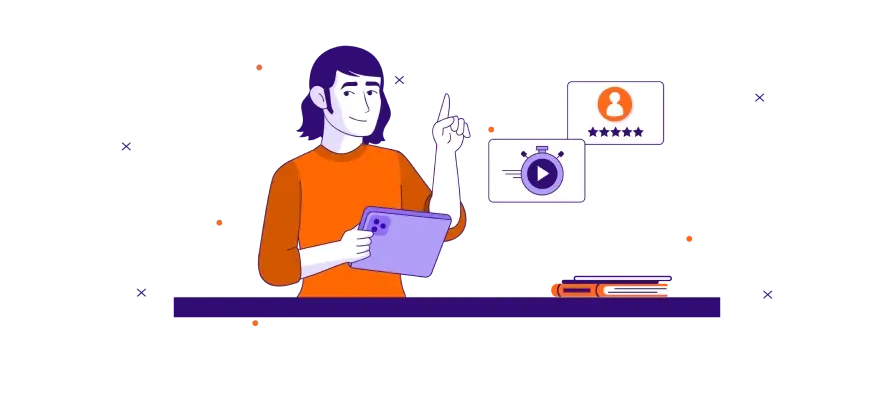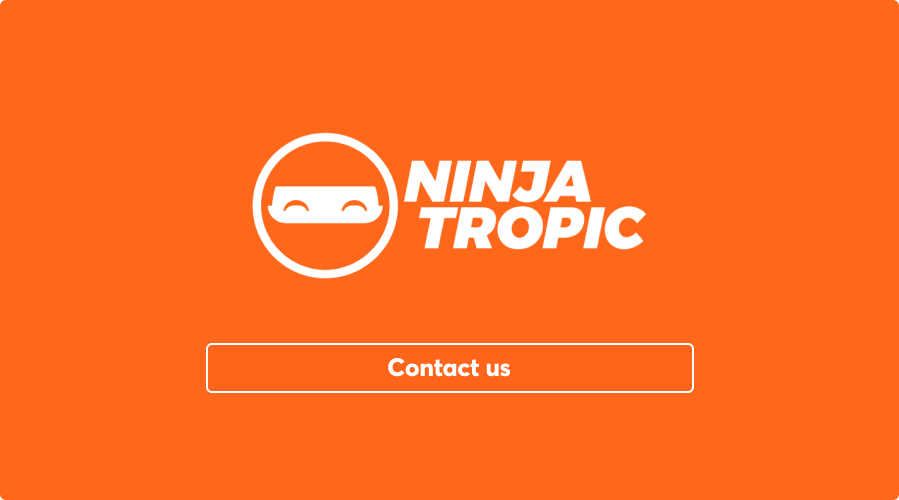
7 Microlearning Tips to Improve Learner Experience (2023 Strategy)

While Polasek and Javorcik (2019) proved the benefits of microlearning, you can’t simply introduce a microlearning system to your employees and let the platform do the job for you.
The platform itself will keep learners engaged and help them learn quickly. However, as the wisest before us said:
“There’s always room for improvement!”
But how? What are the specifics you can look for to improve learner experience?
The goal is to have a solid microlearning strategy when you’re preparing the learning material. You can only do that when you have a clear idea of your learning objectives.
Also, if you want to make microlearning work for you, not against you, you need to monitor everything carefully.
In this article, we will give you 7 clever microlearning strategies to improve overall learning outcomes.
So, let’s hop in…
What Are the Benefits of Implementing a Microlearning Strategy?
Simply put:
-
- Short and varied microlearning videos don’t stress the human attention span
- Better retention due to short lectures and more learner participation
- Easy to access from anywhere
Microlearning takes a different approach to knowledge by breaking down large course material into smaller bite-sized pieces.
As a result, instead of having to sit through a long (and boring) lecture, learners get to absorb short bursts of information.
In fact, microlearning has become the primary means of training employees in many organizations.
Here’s a detailed look at what microlearning can do for your organization:
1. Improved Knowledge Retention
Sitting through lectures or videos doesn’t necessarily mean that you are “learning.”
Learning is a process that involves absorbing new information, retaining it, and reflecting upon it when needed.
And a proper microlearning strategy will allow the learners to retain the knowledge they gather more efficiently. Since the new information is delivered in small chunks, it’s easier to absorb for the learner.
2. Cost and Time Efficient
Setting up a digital learning structure to train your employees takes up company resources. And if you want to see results as early as possible, a proper microlearning strategy is the best approach.
Compared to the traditional e-learning system, microlearning content, like courses, means less time and more efficiency.
3. Fast Learning
Learning takes time. But time’s an invaluable resource when you are running a business and training your employees.
If you need to spend a month educating your employees, your organization will take a hit.
With a proper microlearning roadmap, you can minimize the time it takes for your workers to learn new information. Microlearning allows the learner to learn at their own pace and is often much faster than other learning methods.
4. Better Learners Satisfaction
Millennials and GenZ make up almost half the workforce in the US right now.
And with shorter attention spans becoming a real problem in the current generation, it’s difficult to design training materials that will ensure motivated learners are satisfied.
With a proper strategy implemented during course creation, you can ensure your employees are fully satisfied with the learning experience. You can always seek professional help regarding your business’s microlearning strategy if you’re not sure what to do.
Top 7 Strategy Tips for Microlearning Content
Good learning content is from the learners, by the learners, and for the learners.
If your designed microlearning course cannot bring results, then it’s a clear indication that it’s not optimized for your employees.
There are a few key elements to designing an efficient microlearning program. And while some of these elements may seem basic, failing to address them can lead to subpar learning results.
Let’s have a look…
1. Know Learners and Learning Objectives
Sticking to a single learning style can save you some time, but it won’t help you motivate your learners.
Everyone has different learning preferences. And to create an effective microlearning course, you need to address all your diverse learners.
Some learners respond better to spaced repetition, some have an easier time absorbing a quick video, and some even prefer focused quizzes. And you need to understand your learners to develop varied microlearning modules.
Set your sights on a specific learning outcome and create lessons that your learners respond to in small chunks to keep them engaged and interested.
2. Create Milestones
Information served in a microlearning system is bite-sized, and you need to use that to your advantage.
Set small goals and objectives for your learners and set up small rewards that celebrate their achievements. Celebrating small achievements will give your employees a juicy dopamine hit that’ll keep them hooked on the training.
You might have an entire course planned, but the best approach is to focus on one learning objective at a time.
Break down a longer course into multiple small segments. Once your learner achieves a certain objective, they’d be able to move on to the next steps.

3. Eliminate Distractions
Creating microlearning content that focuses on a singular topic can be difficult.
We often see educators mentioning additional elements that require the learners to divert from the preset path that’s laid out for them. And that can be a problem.
Giving learners a focused approach to new knowledge is essential for effective microlearning courses. When they are taking part in a specific concept, make sure they have all the resources and tools included in the content to know everything about it without having to search online.
You cannot deviate from the topic at hand. Failing to do so will distract the learners and can break the overall microlearning experience.
4. Make it Engaging, Interesting & Fun
People learn better when they’re having fun and find the lesson engaging.
And if you’re designing a microlearning course aimed at learners’ satisfaction, you need to make the content interesting.
Employees in the current generation are often plagued with a shiny object syndrome. So it’s very easy for them to lose focus.
This means if you can’t create interactive content that keeps them interested and motivated, you won’t be able to achieve the company’s learning objective.
Consider adding animated text, microlearning videos, interactive quizzes, games, etc., as part of the course and keep your learners connected with the program.
You can even use real-world scenarios as a basis while designing the courses to give them relevant tasks and challenges.
5. Optimize for Mobile Phones
Did you know that people spend one-third of their waking time on phones?
So, if you don’t utilize the power of mobile devices when you are creating microlearning courses, you’re making a big mistake!
When designing microlearning content, it’s essential for educators to ensure it works on mobile platforms like smartphones, laptops, and tablets.
For companies that have remote employees and workers, having mobile-friendly online content is essential for digital training.
Mobile learning, or m-learning, has become an integral part of microlearning and e-learning in general. With mobile-friendly microlearning content, your employees or students can engage with the material any time they want.
6. Mix and Match Training Types
Learning doesn’t always have to be online when you’re running a business.
Though it can take up a bit of company time and resources, it’s often a good idea to add a bit of in-person training to the program.
The combination of mobile learning and in-house training will help your employees achieve a better learning experience overall. And it also raises morale and motivation among the workforce.
7. Analyze and Monitor Results
Different microlearning platforms for corporate training allow you to monitor and analyze user interaction through the dashboard.
You’ll be able to get insights like:
- Course completion rate
- How long it takes to complete a certain task
- How many employees take part in a course
And the numbers are your friends.
With the data that you gather by monitoring employee performance in a specific course, you can optimize the content to help your learners achieve better results.

How to Get Started With Microlearning
Microlearning offers many benefits, and well-organized training content that focuses on a singular topic can help you teach your employees with higher efficiency.
And shifting to a microlearning structure isn’t as hard as you might think.
Instead of completely redesigning the training materials in your organization, you can take your existing content and shrink it down into smaller digestible pieces.
If your old training consisted of hour-long videos or boring “click-next” presentations, you need to split it into multiple videos that last two to five minutes that discuss the same idea in a sequential way.
Remember: there’s no right or wrong way here. The average length of a microlearning lesson is around 10 minutes. But, as long as you can keep it under 15 minutes, it can be classed as microlearning.
Instead of focusing on time limitations, what you need to think about is the learning objective. When designing a specific course roadmap, make sure you are achieving a result, or rather a learning goal, in each lesson.
As for the number of lessons per course – there’s no limit.
But ideally, a maximum of ten lessons per course should be your target. If it takes more than that, then maybe you should consider breaking the lesson structure into more modules.
With all that in mind, here are a couple of microlearning examples that you can add to a course:
- Short-form, animated text
- Illustrations and Photos
- Audiobooks and Music
- Quizzes and other forms of tests
- Interactive Games with leaderboards
If you still feel confused or intimidated by the whole process, you can always get a free consultation from an eLearning solutions provider for clearer guidelines.
3 Potential Mistakes to Avoid With Microlearning
Bite-sized lessons are fun to absorb, but designing one can be pretty challenging. Here are three mistakes you want to avoid when creating a micro-lesson.
1. Information Overload
The first big mistake you want to avoid is putting too much information in a single lesson. Microlearning works best when the information is delivered in smaller chunks. And overloading your learners with too much information from the get-go will lead to subpar knowledge retention.
2. Too Much Focus on the Clock
Microlearning is supposed to be brief, but the time limit shouldn’t be your primary concern when planning a lesson.
While it’s important to keep the lesson short and sweet, you should make sure you are giving your learners complete information on the topic. Going over the time limit is fine as long as it’s necessary.
3. Sticking to a Single Format
Your microlessons should include a good blend of materials for a complete learning experience. You shouldn’t stick to a single delivery format and instead mix and match videos, infographics, illustrations, and interactive elements in different lessons.
Final Thoughts: Tips for an Effective Microlearning Strategy in 2023
Experimentation is the key to figuring out how microlearning can work for you. That is true for all things in learning and design.
Take some time to see what works and what doesn’t. Don’t shy away from trying new things!
Our guidelines on microlearning strategies should give you a solid foundation to start designing your courses.
Itching to get started?
Book a free consultation with us, and we’ll help you get in touch with the right eLearning solutions for your team.
GET A FREE CONSULTATION
Are you aware of the sheer power of engaging eLearning solutions but not sure where to start? Schedule a free 30-minute consultation with a Ninja Tropic expert to analyze your association, university, or enterprise’s content objectives and map out the interactive blueprint to achieve them.

